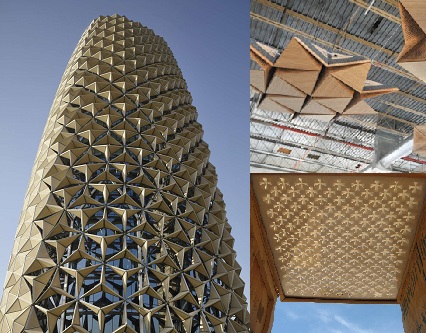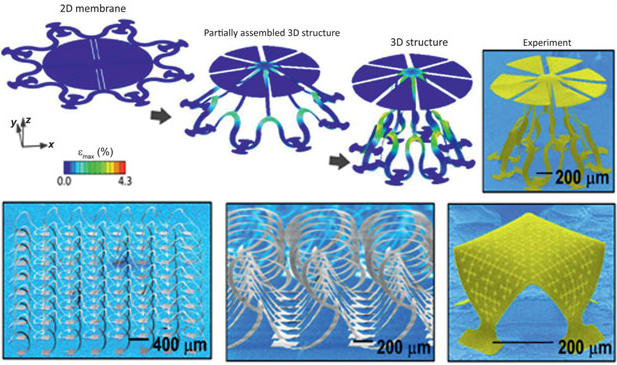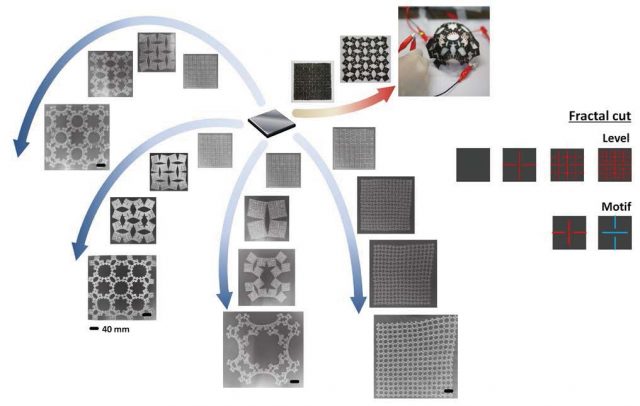Origami, the art of folding
Origami, the ancient art of creating intricate sculptures from a flat sheet of paper, is no longer just a Japanese curiosity, but a cutting-edge manufacturing technique. Just through bending and folding a given material, we can obtain complex 3D structures with applications in electronics, bioengineering or architecture, just to name a few that are currently relevant for this technique. The resulting structures show outstanding mechanical properties, hardly achievable using other conventional manufacturing processes.
Origami-based materials fall into the category of mechanical metamaterials, an interesting group whose properties are defined by their structure rather than the properties of the materials they are made of 1. This reliance on the structure focuses development efforts mainly on the design rules, instead of on tuning materials’ properties.
Most of the best known origami patterns consist of a periodically repeated unit cell of parallelogram faces linked by edges folded into “mountain” and “valley” creases. However, although still quite unexplored, non-periodic structures are gaining attention lately as the finite element simulations get more sophisticate. In both cases, the resulting materials have impressive load bearing capability and buckling resistance, independently of the material properties. The Ron Resch pattern, for instance, is a non-periodic rigid origami widely used in architecture, as it is shown in the images below. And Ron Resch, an American artist, computer scientist and geometrist, is a good example of Art and Science converging to achieve both function and aesthetics.

In the hands of mathematicians, scientists and engineers, origami has found multiple applications in the fields of micro- and nano-electronics (for the development of electronic circuits, sensors, and robotic constructs), as well as in bioengineering (for the replication of complex 3D bio-structures such as vascular networks, neural circuits or cytoskeletons). All these examples have a common challenge: the miniaturization of complex structures, with potentially hundreds or thousands of folds, without losing the very specific mechanical properties they need for an optimal performance.
Let’s look at the Miura-ori pattern pictured below. This is a zigzag-based origami pattern that is being currently used for the development of super-flexible devices such as smart fabrics, soft tissues or stretchable batteries and supercapacitors2. Miura-ori has a remarkable property common to many mechanical metamaterials: it has a negative Poisson´s ratio. This parameter accounts for the behaviour of a material in the transverse axes when compressed along its length. For most materials, Poisson´s ratio is positive, meaning that it will become thicker under compression (barrel-shaped) and thinner when stretched. But there are a bunch of peculiar materials, named auxetic materials, which behave the opposite: they become thinner under compression and thicker under stretch.

But, what are the advantages of a material with a negative Poisson’s ratio? To begin with, auxetic materials tend to densify under compression (they become more condensed, instead of increasing their volume in the transverse direction), leading to enhanced fracture toughness, indentation resistance and energy absorption. They also have the ability to anchor to the surrounding system: when subjected to a compressive force their lateral contraction makes it easier for them to be inserted inside a cavity, while applying a tensile force makes them thicker and hard to remove from the same cavity. These peculiarities have found interesting applications in the development of scaffolds for tissue engineering, implants, drug delivery systems or expandable devices for laparoscopic surgery 3. And this is not just a man-made invention. Auxetic materials are also present in nature in certain crystalline silicates, tendons, skin tissues and others suspected but still not proved such as some forms of bone.
This combination of complex 3D architectures and improved mechanical properties is common to most of the origami-based materials, and that´s why they attract so much attention lately. Going one step further we find kirigami-based materials. If origami consists of folding and bending, kirigami allows also cutting. Adding cuts to the pattern allows playing around with curvatures, density, strains and many other possibilities that enable an amazing variety of forms, structures and eventually, a variety of architectures and deformation behaviours. So many possibilities indeed, that exceed current attempts to comprehensively cover the potential applications of kirigami-based materials.
Moreover, kirigami assemblies combine really well with the latest manufacturing techniques currently used for producing micro- and nano-electronic devices, such as planar lithography, where 2D patterns are popped up into 3D structures as shown in the images below. This allows large scale fabrication and importantly, an independence of the material selected.

Interesting approaches include the development of hierarchical structures by fractal cut patterns. In this process, a simple pattern of cuts (the motif) is produced on a square unit. Then, the unit is divided into smaller units in which the cut pattern is repeated theoretically ad infinitum, but in practice for a finite number of levels, which leads to a multiscale hierarchical architecture with enhanced expandability upon stretching. In the image below we can see this technique applied to a silicon rubber sheet, coated with a thin conducting film which has been made completely stretchable by fractal cutting without losing any of its electrical properties. As mentioned before, this design-focused approach is a good alternative to material-focused developments, as it reduces the need for long material selection processes and testing campaigns.

Like most of the latest advances in Material Science, origami and kirigami based materials will be developed mainly by high-performance computing centers rather than in a lab, and it will take some time until these novel techniques become widespread as large scale manufacturing processes. This is just one of many examples in which we can observe the trend towards the development of highly complex, tailor-made materials, combining multiple functionalities and intricate structures, which, in addition, can be scale down to the nanoscale to meet the most demanding requirements. Don’t miss the next chapter!
References
- Cheng Lv et al, Origami based Mechanical Metamaterials, Scientific Reports 4, 5979 (2014) doi:10.1038/srep05979 ↩
- Eidini M, Zigzag-base folded sheet cellular mechanical metamaterials, Extreme Mechanics Letters, Vol 6, 96-102 (2016) doi:10.1016/j.eml.2015.12.006 ↩
- Lee W et al, Controlled unusual stiffness of mechanical metamaterials, Scientific Reports 6, 20312 (2016) doi: 10.1038/srep20312 ↩